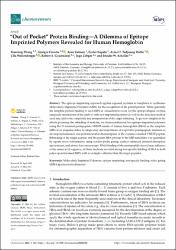| dc.contributor.author | Zhang, Xiaorong | |
| dc.contributor.author | Caserta, Giorgio | |
| dc.contributor.author | Supala, Eszter | |
| dc.contributor.author | Wollenberger, Ulla | |
| dc.contributor.author | Gyurcsányi, Róbert E. | |
| dc.contributor.author | Zebger, Ingo | |
| dc.contributor.author | Scheller, Frieder W. | |
| dc.contributor.author | Yarman, Aysu | |
| dc.date.accessioned | 2024-04-24T18:20:32Z | |
| dc.date.available | 2024-04-24T18:20:32Z | |
| dc.date.issued | 2021 | en_US |
| dc.identifier.citation | Zhang, X., Caserta, G., Supala, E., Wollenberger, U., Gyurcsányi, Róbert E., Zebger, I., Scheller, Frieder W., Yarman, A. (2021). “Out of pocket” protein binding—A dilemma of epitope imprinted polymers revealed for human hemoglobin. Chemosensors, 9 (6). | en_US |
| dc.identifier.uri | https://hdl.handle.net/20.500.12846/1150 | |
| dc.description.abstract | The epitope imprinting approach applies exposed peptides as templates to synthesize
Molecularly Imprinted Polymers (MIPs) for the recognition of the parent protein. While generally
the template protein binding to such MIPs is considered to occur via the epitope-shaped cavities,
unspecific interactions of the analyte with non-imprinted polymer as well as the detection method
used may add to the complexity and interpretation of the target rebinding. To get new insights on the
effects governing the rebinding of analytes, we electrosynthesized two epitope-imprinted polymers
using the N-terminal pentapeptide VHLTP-amide of human hemoglobin (HbA) as the template.
MIPs were prepared either by single-step electrosynthesis of scopoletin/pentapeptide mixtures or
electropolymerization was performed after chemisorption of the cysteine extended VHLTP peptide.
Rebinding of the target peptide and the parent HbA protein to the MIP nanofilms was quantified
by square wave voltammetry using a redox probe gating, surface enhanced infrared absorption
spectroscopy, and atomic force microscopy. While binding of the pentapeptide shows large influence
of the amino acid sequence, all three methods revealed strong non-specific binding of HbA to both
polyscopoletin-based MIPs with even higher affinities than the target peptides. | en_US |
| dc.language.iso | eng | en_US |
| dc.relation.isversionof | 10.3390/chemosensors9060128 | en_US |
| dc.rights | info:eu-repo/semantics/openAccess | en_US |
| dc.subject | Molecularly imprinted polymers | en_US |
| dc.subject | Epitope imprinting | en_US |
| dc.subject | Non-specific binding | en_US |
| dc.subject | Redox gating | en_US |
| dc.subject | SEIRA spectroelectrochemistry | en_US |
| dc.title | “Out of pocket” protein binding—A dilemma of epitope imprinted polymers revealed for human hemoglobin | en_US |
| dc.type | article | en_US |
| dc.relation.journal | Chemosensors | en_US |
| dc.contributor.authorID | 0000-0002-1465-9848 | en_US |
| dc.identifier.volume | 9 | en_US |
| dc.identifier.issue | 6 | en_US |
| dc.relation.publicationcategory | Makale - Uluslararası Hakemli Dergi - Kurum Öğretim Elemanı | en_US |
| dc.contributor.department | TAÜ, Fen Fakültesi, Moleküler Biyoteknoloji Bölümü | en_US |

















